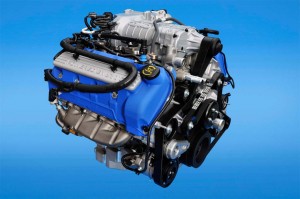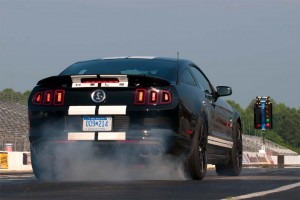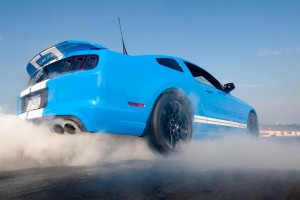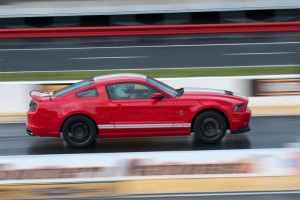Ever since Chevrolet brought back the Camaro, a few years back, the pony car wars have turned into a real firefight. Anyone who thought that we’re long past the gold are of the American muscle car just has to spend a little time behind the wheel of one of the latest offerings from Chevy, Chrysler or Ford.
The latter maker pretty much had the class pony car segment all to itself for a number of years, but Mustang has had a tough time since Camaro’s return. Who says competition isn’t a wonderful thing? Both makers – and Chrysler, with the Challenger – have made some amazing improvements lately. As we discovered getting behind the wheel of Ford’s latest spin on the Mustang, the 2013 Ford Shelby GT500.
Ford’s ties to Shelby go back nearly half a century, the first Shelby Mustang proving that the little coupe approved by Lee Iacocca and company was more than just a sexy little poseur. In recent years, we’ve seen the Shelby imprimatur on a series of impressive Mustangs, including one now coming out of the late Carroll Shelby’s own tuner shop near Las Vegas.
Don’t confuse that customized Mustang with the one Ford is rolling off its own assembly line. The Shelby American version is a low-volume offering that, for nearly as much as you’d pay for a Ferrari will get you a mind-boggling 950 horsepower – a reported 1,100 in track trim. By comparison, the Ford Shelby GT500 will “only” churn out 662 horsepower and 631 lb-ft of torque.
But there’s no reason to lament. That’s still a whopping 82 hp more than the new Chevy Camaro ZL1; more, in fact, than the Corvette ZR1. And, according to Ford, it’s enough to launch you from 0 to 60 in less than 4 seconds (we’re hearing and experiencing numbers that drop as low as 3.5 seconds with the optional Performance Package), and which will get you to a Ferrari-class 202 mph in the Shelby GT500 Coupe. The Convertible is limited to just 155 mph, sadly.
The numbers are truly impressive, especially considering the big bump from the 2012 Shelby. The 2013 model makes the numbers thanks to a bore increase that bumps the old 5.4-liter DOHC V-8 to 5.8 liters. The block is specially gas in Germany and among other changes it gets modified pistons and rods, crankshaft and connecting rods similar to those previously used in the Ford GT supercar. And a special plasma-coated cylinder liner – which replaces the old cast-iron liner – reduces both weight and friction.

The 2013 Ford Shelby GT500 engine is bumped up to 5.8 liters and now makes more power than a Corvette ZR-1.
There’s now a Roots-style supercharger capable of 14 psi boost compared to 9 in the 2012 Shelby. It’s a good thing the updated engine can go into over-rev mode for up to 8 seconds – allowing the redline to jump from 6,250 RPMs to 7,000 during a serious launch. To make sure all the power gets to the rear wheels there’s a new carbon fiber driveshaft that weighs nearly 15 pounds less than before but which can handle a third more torque.
And to ensure you get one the 2013 Shelby GT500 gets a new Launch Control system. Triggered by a button on the steering wheel, it picks the ideal RPM, letting you hold the pedal to the metal before dumping the clutch.
“In the day,” straight-line acceleration might have been all you’d ask for from a Golden Age pony car. Not today. One expects to be able to give good chase to a BMW M even when you’re on the back roads.
And that’s where Ford has pulled off a second technological coup. The new Bilstein adjustable shocks are operated by a push of the dash-mounted button and can be instantly switched from “Normal” mode to “Sport,” which speeds up response time, while reducing both body roll and pitch under braking.
Shifting to Sport mode will give you maximum control on the track. But that does have its drawbacks; the ride is harsh to the point of jarring, especially on the broken tarmac that passes for most Michigan roads. The GT500 is reasonably well mannered in Normal and could be left there for all but the most aggressive driving, in fact.
Handling is all the more impressive when you realize that the long-lived (polite-speak for “ancient”) Mustang platform retains its live rear axle. Then again, even the base Ford pony car handles a bit better than the comparable Camaro despite the Chevy offering’s IRS. And word is that the 2014 50th anniversary of the Mustang will see an all-new model with independent rear and other modern updates.
Braking, meanwhile, is markedly enhanced over a more mainstream Mustang – or the 2012 Shelby thanks to the GT500’s big Brembos. We’re talking 15.0-inch rotors with 6-piston calipers up front, 13.8-inch vented rotors in the rear. If the 5.8-liter V-8 will give your neck a snap on launch expect this brake package to give you a nosebleed if you’re not careful.
There are trade-offs with the Shelby. You can feel the weight, a hefty 3,970 pounds, though the GT500 is more nimble than that number alone might suggest. And, yes, we really do hope the next-gen Mustang, never mind one wearing a Shelby badge, does come with IRS. But our single biggest complaint is the Shelby GT500 Convertible’s ragtop, which might have been around in the Flintstone’s era. For nearly $65,000 with delivery charges should any car still require us to be snapping and unsnapping latches?

The 2013 Ford Shelby GT500's big V-8 can over-rev for up to 8 seconds for maximum launch acceleration.
As to fuel economy, expect 15 mpg in the City, 24 on the Highway, according to the EPA. Not bad numbers for power like this. Of course, if you’re someone with a heavy foot – which is likely anyone who’d buy the 2013 Ford Shelby GT500 – we’d suggest you anticipate significantly lower mileage than the feds get in their standardized testing procedures. Those apparently don’t include Launch Control burnouts.
But all things considered, for those who want raw power with unexpectedly good road manners – and the classic Detroit V-8 exhaust note – the 2013 Ford Shelby GT500 is worth a closer look if you can get one to slow down long enough.




